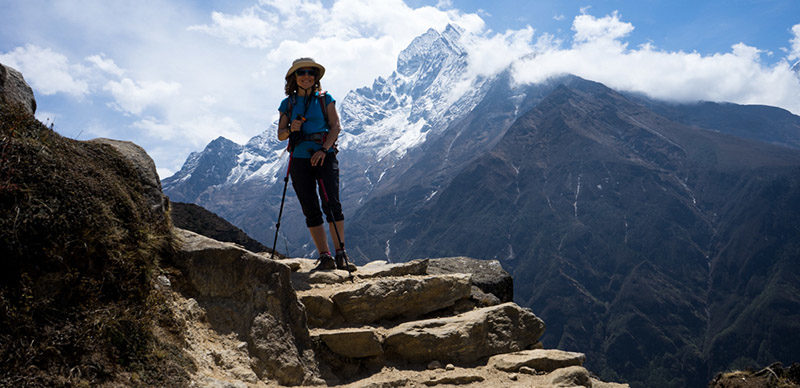Everest base camp trek presents 5 top attractions in Nepal, an amazing travel location. Here are some tips if you plan to tour Himalaya.
Langtang area is famous for trekking. The area is less crowded and best for different kind of taste of culture and Himalayan views. The close up views of Langtang Himalayan range is mind blowing. The scenery here is spectacular, and the trek more adventurous as the area is visited by fewer tourists. To the west of Langtang is Ganesh Himal with a range of 6000 to 7000 meters. The Gosainkund and Helambu region lies to its south; these can be combined with Langtang to make treks from 7 days to 21 days. The area was designated Nepal’s first Himalayan National Park in 1971; it is inhabited by Tamang and Sherpa people whose religious practices, language and dress are much more similar to those of Tibet than to the traditions of their cousins in the middle hills. The forests in the region have temperate and sub-alpine vegetation. Wildlife includes migratory birds, deer, monkey, Tahr and Pika. The best time for trekking the Langtang area is spring and autumn. Most of the trekking routes in Helambu and Langtang are well served with teahouses making independent trekking quite possible. But there are no such facilities in the Ganesh Himal area or Ganja La area. A journey to the Langtang valley offers an opportunity to explore the Tamang villages, climb small peaks and to visit glaciers at a more comfortable altitude than other trekking regions.
Stay Out of the Sun Whenever Possible. The higher you go up in altitude, the lower the levels of UV Protection you are getting. Some days on the trail, the sun can be brutal, giving you solar radiation from its powerful rays. Staying out of the sun is not only good for minimizing those pesky wrinkles and avoiding skin cancer, but it can also improve your chance of being successful on the trek. When you get sunburned you become dehydrated, and back to the tip of keeping yourself hydrated, being dehydrated can cause all sorts of problems in the mountains and eventually limiting your chance of success. Of course, when you are walking during the day, there may be no cover from those potent rays, but you need to take as much care as possible to minimize those harsh emissions. The first way to protect yourself if by applying a factor 50 sunblock throughout the day. The mountain is not the place to top up that holiday tan you are hoping to bring back to work with you on your return home, when you get back to Kathmandu after the climb, you can do as you please, but while in the mountains, you need to block those harmful rays from your skin. The second way of protecting yourself is to always wear your goofy looking, yet extremely important, sun hat. Get yourself a light weight, brimmed sunhat to wear on days when the sun is shining and you will save yourself from some of the dreaded headaches you so adamantly want to avoid.
Trekking in Everest region is the most popular activity of the visitors. The Everest region is the home of Mount Everest, Lhotse, Nuptse, Amadabalam, Pumori and many other famous mountains. Likewise the region is the homeland of Sherpa people. Everest region is known as the home of Sherpa people and the mysterious Yeti. Everest region trekking destination is located in the eastern part of Nepal. There are several choices of trekking, peak climbing and mountaineering. In this region several well developed trekking trail like Everest Base Cap Trek, Gokyo Lake Trek and many other trails are busy to service the trekkers. Some trails are remote semi-wilderness areas, there is a choice to suit all-corners.
Top advices : Take your time. It is not a race and nobody is judging how quickly you get up the hill. Acclimatize properly, drink plenty of water and if you need to take an extra rest day. Nobody is going to ask you how long it took you to get to Everest Base Camp, they are just going to be amazed that you did it. Your guide and porter will not mind if you hire them for an extra day or two. They will be glad for the work. Treks are flexible on Everest if you book in Kathmandu or when you arrive in Lukla.
Besides these, luxurious treks that let you stay in the finest hotels and provide helicopter rides are also available. These treks are flexible and customizable as per the client’s wish. The Everest Base Camp-12 Days trek offers the trek along the much-loved trekking routes in the region. The trail passes through Namche, Thyangboche, Dingboche, and Lobuche until we reach Gorak Shep. We acclimatize once at Namche and again at Dingboche. From Gorak Shep, we trek to the spectacular Everest Base Camp and experience the exquisite view of sunrise from Kala Pathar. We end our journey with a flight back to Kathmandu. See extra details on https://www.adventuregreathimalaya.com/nepal/trekking-in-nepal-himalaya-trekking/everest-base-camp-trekking/.
Take Care of Your Feet – Bad blisters can end a trek just as easily as altitude sickness. I recommend brining some duct tape or moleskin and treating as soon as you start to feel discomfort and not after it becomes an actual blister. Getting a Good Night’s Rest – You will probably be surprised at how comfortable the tea houses are on the trek but the bedroom walls are thin and noise carries quite easily. If you’re a light sleeper I recommend bring some foam ear plugs for a good night’s sleep. While it might be warm trekking during the day its definetly cold at night so make sure you have a warm sleeping bag and thermals. The sleeping bags we rent are -20C and plenty warm.
